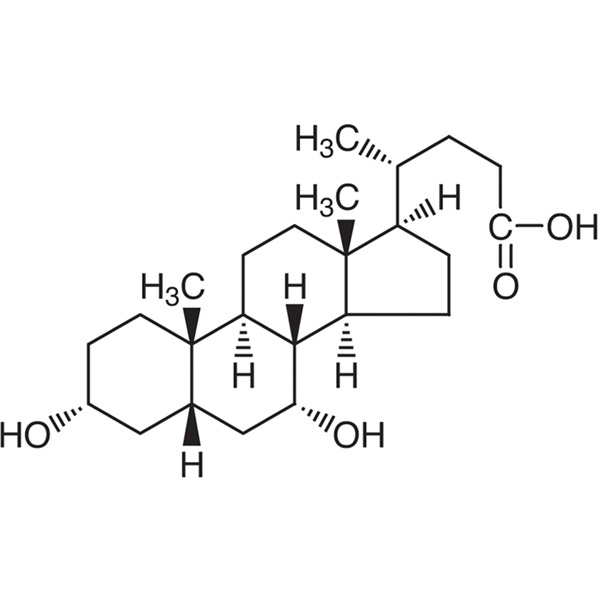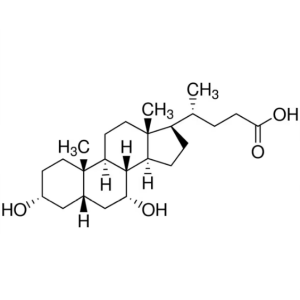Chenodeoxycholic Acid (CDCA) CAS 474-25-9 Assay ≥98% (Dry Basic)
Ruifu Chemical is the leading manufacturer of Chenodeoxycholic Acid (CDCA; Chenodiol) (CAS: 474-25-9) with high quality. Ruifu Chemical can provide worldwide delivery, competitive price, excellent service, small and bulk quantities available. Purchase Chenodeoxycholic Acid, Please contact: alvin@ruifuchem.com
| Chemical Name | Chenodeoxycholic Acid |
| Synonyms | Chenodeoxycholic Acid, Free Acid; CDCA; Chenodiol; 3α,7α-Dihydroxy-5β-Cholanic Acid; 5β-Cholanic Acid-3α,7α-diol; 5β-Cholanic Acid-3α,7α-diol; 3alpha, 7alpha-Dihydroxy-5beta-Cholanic Acid; (+)-Chenodeoxycholic Acid; Ursodeoxycholic Acid EP Impurity A |
| Stock Status | In Stock, Commercial Production |
| CAS Number | 474-25-9 |
| Molecular Formula | C24H40O4 |
| Molecular Weight | 392.58 g/mol |
| Melting Point | 164.0~169.0℃(lit.) |
| Water Solubility | Practically Insoluble in Water |
| Solubility in Methanol | Almost Transparency |
| Solubility | Very Soluble in Acetone, Alcohol. Soluble in Ether. Insoluble in Benzene |
| Sensitive | Sensitive to Light |
| COA & MSDS | Available |
| Sample | Available |
| Origin | Shanghai, China |
| Brand | Ruifu Chemical |
| Items | Specifications | Results |
| Appearance | White or Light Yellow Similar Crystalline Powder.
Taste Bitter, Foreign Odor |
Complies |
| Specific Optical Rotation | +11.0°~+13.0° | +11.8° |
| Identification 1 | The color of solution from light red to dark green. | Complies |
| Identification 2 | The color of solution should be red violet. | Complies |
| Acidity | ≤0.5ml | 0.27ml |
| Chloride | ≤0.016% | <0.016% |
| Heavy Metals | ≤20ppm | <20ppm |
| Barium Salt | No Turbidity is Appeared | No |
| Loss on Drying | ≤2.00% | 1.5% |
| Residue on Ignition | ≤0.20% | 0.11% |
| Related Substances | TLC | Complies |
| Cholic Acid | ≤2.00% | 1.8% |
| Lithocholic Acid | ≤1.00% | 0.2% |
| Ursodesoxycholic Acid | ≤1.00% | 0.6% |
| Assay | ≥98% (dry basic) | 98.7% |
| Infrared Spectrum | Consistent with Structure | Complies |
| Conclusion | The product has been tested and complies with the given specifications | |
Package: Bottle, Aluminium foil bag, 25kg/Cardboard Drum, or according to customer's requirement.
Storage Condition: Keep the container tightly closed and store in a cool, dry and well-ventilated warehouse away from incompatible substances. Protect from light and moisture. Incompatible with strong oxidizing agents.
Shipping: Deliver to worldwide by air, by FedEx / DHL Express. Provide fast and reliable delivery.
Chenodeoxycholic Acid
C24H40O4: 392.57
3a,7a-Dihydroxy-5b-cholan-24-oic acid [474-25-9]
Chenodeoxycholic Acid, when dried, contains not less than 98.0z and not more than 101.0% of C24H40O4.
Description Chenodeoxycholic Acid occurs as white, crystals, crystalline powder or powder.
It is freely soluble in methanol and in ethanol (99.5), soluble in acetone, and practically insoluble in water.
Identification Determine the infrared absorption spectrum of Chenodeoxycholic Acid, previously dried, as directed in the potassium bromide disk method under Infrared Spectrophotometry <2.25>, and compare the spectrum with the Reference Spectrum: both spectra exhibit similar intensities of absorption at the same wave numbers.
Optical rotation <2.49> [a]20D : +11.0 °~ +13.0° (after drying, 0.4 g, ethanol (99.5), 20 mL, 100 mm).
Melting point <2.60> 164~169℃
Purity (1) Chloride <1.03>-Dissolve 0.36 g of Chenodeoxycholic Acid in 30 mL of methanol, add 10 mL of dilute nitric acid and water to make 50 mL, and perform the test with this solution. Prepare the control solution as follows: To 1.0 mL of 0.01 mol/L hydrochloric acid VS add 30 mL of methanol, 10 mL of dilute nitric acid and water to make 50 mL (not more than 0.1%).
(2) Heavy metals <1.07>-Proceed with 1.0 g of Chenodeoxycholic Acid according to Method 4, and perform the test. Prepare the control solution with 2.0 mL of Standard Lead Solution (not more than 20 ppm).
(3) Barium-To 2.0 g of Chenodeoxycholic Acid add 100 mL of water, and boil for 2 minutes. To this solution add 2 mL of hydrochloric acid, boil for 2 minutes, filter after cooling, and wash the filter with water until to get 100 mL of the filtrate. To 10 mL of the filtrate add 1 mL of dilute sulfuric acid: no turbidity is appeared.
(4) Related substances-Dissolve 0.20 g of Chenodeoxycholic Acid in a mixture of acetone and water (9:1) to make exactly 10 mL, and use this solution as the sample solution. Separately, dissolve 10 mg of lithocholic acid for thin-layer chromatography in the mixture of acetone and water (9:1) to make exactly 10 mL. Pipet 2 mL of this solution, add the mixture of acetone and water (9:1) to make exactly 100 mL, and use this solution as the standard solution (1). Separately, dissolve 10 mg of ursodeoxycholic acid in the mixture of acetone and water (9:1) to make exactly 100 mL, and use this solution as the standard solution (2). Separately, dissolve 10 mg of cholic acid for thin-layer chromatography in the mixture of acetone and water (9:1) to make exactly 100 mL, and use this solution as the standard solution (3). Pipet 1 mL of the sample solution, and add the mixture of acetone and water (9:1) to make exactly 20 mL. Pipet 0.5 mL, 1 mL, 2 mL, 3 mL and 5 mL of this solution, add the mixture of acetone and water (1) to each of them to make exactly 50 mL, and designate these solutions as standard solution A, standard solution B, standard solution C, standard solution D and standard solution E, respectively. Perform the test with these solutions as directed under Thin-layer Chromatography <2.03>. Spot 5 mL each of the sample solution, standard solutions (1), (2), (3) and standard solutions A, B, C, D and E on a plate of silica gel for thin-layer chromatography. Develop the plate with a mixture of 4-methyl-2-pentanone, toluene and formic acid (16:6:1) to a distance of about 15 cm, airdry the plate, and further dry at 1209C for 30 minutes. Immediately, spray evenly a solution of phosphomolybdic acid n-hydrate in ethanol (95) (1 in 5) on the plate, and heat at 120℃ for 2 to 3 minutes: the spot corresponding to the spot with the standard solution (1) is not more intense than the spot with the standard solution (1), the spot corresponding to the spot with the standard solution (2) is not more intense than the spot with the standard solution (2), and the spot corresponding to the spot with the standard solution (3) is not more intense than the spot with the standard solution
(3). As compared to the spots with the standard solutions A, B, C, D and E, the spots other than the principal spot and other than the spots mentioned above are not more intense than the spot with the standard solution E, and the total amount of them is not more than 1.5%.
Loss on drying <2.41> Not more than 1.5%(1 g, 105℃,3 hours).
Residue on ignition <2.44> Not more than 0.1% (1 g).
Assay Weigh accurately about 0.5 g of Chenodeoxycholic Acid, previously dried, dissolve in 40 mL of ethanol (95) and 20 mL of water, and titrate <2.50> with 0.1 mol/L sodium hydroxide VS (potentiometric titration). Perform a blank determination in the same manner, and make any necessary correction.
Each mL of 0.1 mol/L sodium hydroxide VS = 39.26 mg of C24H40O4
Containers and storage Containers-Tight containers.
How to Purchase? Please contact Dr. Alvin Huang: sales@ruifuchem.com or alvin@ruifuchem.com
15 Years Experience? We have more than 15 years of experience in the manufacture and export of a wide range of high quality pharmaceutical intermediates or fine chemicals.
Main Markets? Sell to domestic market, North America, Europe, India, Korea, Japanese, Australia, etc.
Advantages? Superior quality, affordable price, professional services and technical support, fast delivery.
Quality Assurance? Strict quality control system. Professional equipment for analysis include NMR, LC-MS, GC, HPLC, ICP-MS, UV, IR, OR, K.F, ROI, LOD, MP, Clarity, Solubility, Microbial limit test, etc.
Samples? Most products provide free samples for quality evaluation, shipping cost should be paid by customers.
Factory Audit? Factory audit welcome. Please make an appointment in advance.
MOQ? No MOQ. Small order is acceptable.
Delivery Time? If within stock, three days delivery guaranteed.
Transportation? By Express (FedEx, DHL), by Air, by Sea.
Documents? After sales service: COA, MOA, ROS, MSDS, etc. can be provided.
Custom Synthesis? Can provide custom synthesis services to best fit your research needs.
Payment Terms? Proforma invoice will be sent first after confirmation of order, enclosed our bank information. Payment by T/T (Telex Transfer), PayPal, Western Union, etc.
Hazard Symbols Xn - Harmful
Risk Codes 63 - Possible risk of harm to the unborn child
Safety Description S22 - Do not breathe dust.
S24/25 - Avoid contact with skin and eyes.
S45 - In case of accident or if you feel unwell, seek medical advice immediately (show the label whenever possible.)
S36/37 - Wear suitable protective clothing and gloves.
UN IDs UN1230 - class 3 - PG 2 - Methanol, solution
WGK Germany 2
RTECS FZ1980000
HS Code 2918990090
Chenodeoxycholic Acid (CDCA; Chenodiol) (CAS: 474-25-9) is a bioactive molecule extracted from the bile of chicken, duck, goose, etc., which can be used to prevent and treat cholesterol gallstones and hyperlipidemia, and also has a certain effect on bile pigment stones and mixed stones. In addition, the compound can be used to investigate the substrate range of newly discovered organic reactions in the study of organic synthesis methodology, and has certain applications in the study of basic biochemistry.
Chenodeoxycholic Acid is the first agent to be introduced into the US market for the treatment of radiolucent gallstones. Large scale clinical trials have demonstrated the safety and efficacy of this agent. Chenodeoxycholic acid reduces the biliary concentration of cholesterol relative to that of bile acids and phospholipid, reducing the saturation and thus the lithogenicity of the bile. Success rates in dissolving gallstones are in the range of 50-70% within 4-24 months of treatment. Continuation of the drug after stone dissolution may be required to prevent reoccurrence. Chenodeoxycholic acid is the 7α-isomer of ursodeoxycholic acid which was introduced into the European market in 1978.
This strain was extracted from the bile of chicken, duck, goose, etc. It is synthesized by cholesterol in the liver and is a free bile acid component in normal bile. Bile contains cholic acid and Chenodeoxycholic acid 30% ~ 40%, deoxycholic acid 10% ~ 20%, lithocholic acid and ursodeoxycholic acid less than 5%, in addition, there are lecithin, cholesterol and bilirubin and other excreta. It can reduce the synthesis and secretion of cholesterol, reduce the total cholesterol excretion of bile, improve the dissolving power of bile to cholesterol, and promote the dissociation of cholesterol from stones to achieve the effect of dissolving stones.
Take fresh or frozen chicken (or duck, goose) bile, add 1/10 amount of industrial sodium hydroxide, heat and boil for 20~24h, and constantly replenish the amount of water evaporated, cooling, and then hydrochloric acid to adjust the pH value of 2~3, the appearance of black paste. After the mixture was allowed to stand and layered, the paste was taken out and washed with water until neutral to obtain total bile acid. Add 2 times the amount of total bile acid 95% ethanol and 10% activated carbon, heating reflux 2~3H, while hot filtration. The filtrate was cooled, then extracted with equal volume of 1 20# gasoline for 3 times for degreasing, left to stand and layered, and the lower liquid was separated and compressed to obtain paste. A large amount of water was added to the paste to precipitate a precipitate, which was washed with water until colorless. The precipitate was then adjusted to pH 95% by adding 2-fold amounts of 8.5 ethanol and 5% sodium hydroxide solution and heated to reflux for 2H. Then add barium chloride in an amount of 150 grams per liter, heat and reflux for 2H, filter while hot, concentrate the filtrate to appear crystal film or turbidity, let it cool, precipitate crystals, suction filter, wash with water, drying under reduced pressure, white Chenodeoxycholic acid barium salt crystals can be obtained. Then the barium salt is dissolved with water, and sodium carbonate of about 12% of the barium salt is added, heated and stirred, filtered, and the barium carbonate precipitate is discarded. The filtrate is adjusted to pH 2-3 with hydrochloric acid to precipitate and filter, filter cake water to neutral, dry, available Chenodeoxycholic acid product. If necessary, it can be recrystallized with ethyl acetate for 1 to 2 times. There are also methods of extraction using calcium chloride salts.
Suitable for the prevention and treatment of cholesterol gallstones. Dissolving gallstone drugs. It is used to prevent and treat cholesterol gallstones and hyperlipidemia, and has certain curative effect on bile pigment stones and mixed stones. For patients with mild symptoms, good gallbladder function and no obstruction of biliary tract, the curative effect is better. Long-term use has mild diarrhea, a small number of patients may have itching, dizziness, nausea and abdominal distension, individual patients can induce biliary colic and temporary transaminase elevation. Pregnant women, women of childbearing age, pancreatitis, liver cirrhosis, gastric and duodenal ulcers, hepatitis and biliary obstruction are prohibited. This product is a dissolving agent for cholesterol gallstones. Mainly used to prevent and treat cholesterol cholelithiasis. Mainly used as an intermediate of ursodeoxycholic acid. Biochemical research; used for the synthesis of ursodeoxycholic acid; gallstone dissolving agent, used for stones, biliary tract inflammation and cholecystitis caused by high cholesterol. A bile acid synthesized by cholesterol in the liver, and a selective DD2 inhibitor. suitable for the prevention and treatment of cholesterol gallstones.
Function of Chenodeoxycholic Acid
1. Chenodeoxycholic Acid is a dissolving agent for cholesterol gallstones. It is mainly used for the prevention and treatment of cholesterol gallstone disease.
2. Mainly used as intermediate of Ursodeoxycholic Acid
3. Biochemical studies; used in the synthesis of ursodeoxycholic acid; gallstone dissolver, used for stones caused by high cholesterol, biliary tract infection and cholecystitis, etc.
-
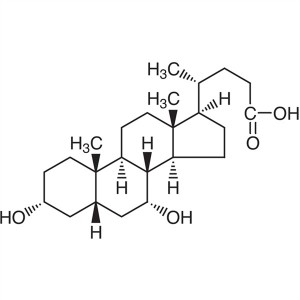
Chenodeoxycholic Acid (CDCA) CAS 474-25-9 Assay...
-
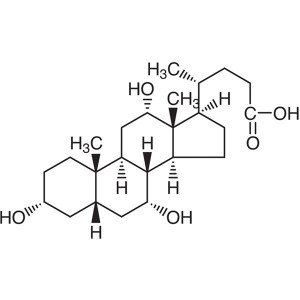
Cholic Acid CAS 81-25-4 Purity >98.0% (HPLC) Fa...
-
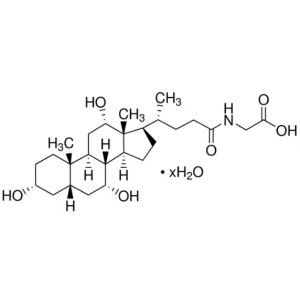
Glycocholic Acid Hydrate CAS 475-31-0 Assay 98....
-
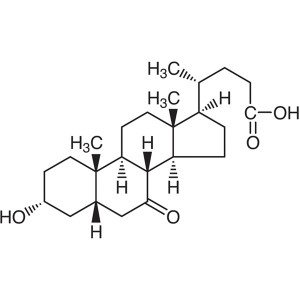
3α-Hydroxy-7-oxo-5β-Cholanic Acid CAS 4651-67-6...
-
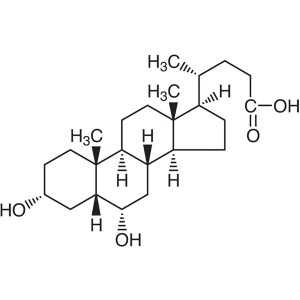
Hyodeoxycholic Acid (HDCA) CAS 83-49-8 Assay 99...
-
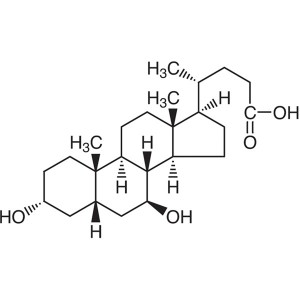
Ursodeoxycholic Acid (UDCA) CAS 128-13-2 Assay ...
-
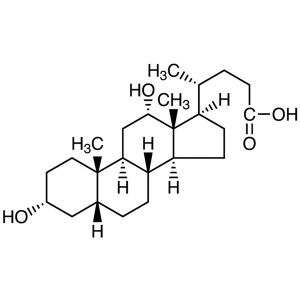
Deoxycholic Acid CAS 83-44-3 Purity >98.0% (T) ...
-
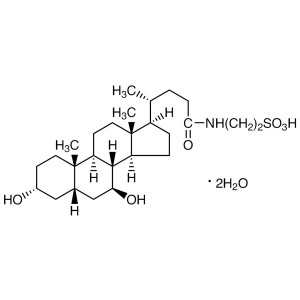
Tauroursodeoxycholic Acid Dihydrate CAS 14605-2...
-
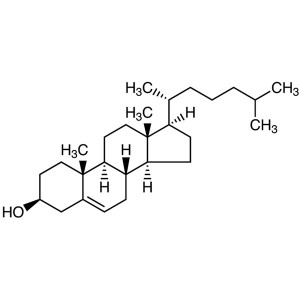
Cholesterol CAS 57-88-5 High Quality
-
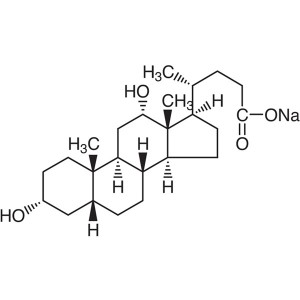
Sodium Deoxycholate CAS 302-95-4 Assay 97.5~102.5%

